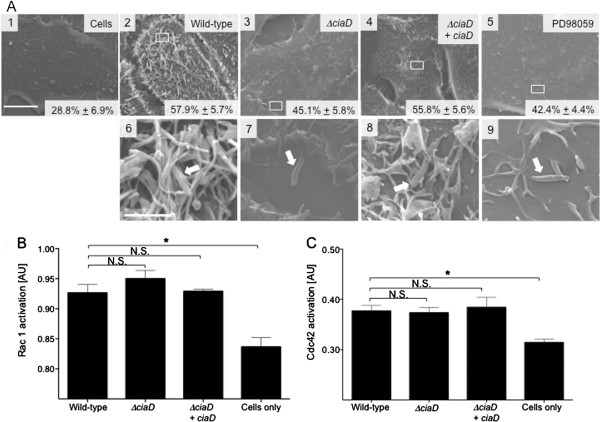Figure 2.
CiaD induced host cell membrane ruffling is Rho GTPase independent. A. Representative scanning electron microscopy images of INT 407 cells; uninfected (Panel 1), infected with a C. jejuni wild-type strain (2 and 6), ciaD mutant (3 and 7), ciaD complemented isolate (4 and 8), and cells infected with a C. jejuni wild-type strain that had been pretreated with PD98059, an inhibitor of Erk 1/2 activation (5 and 9). Arrows in higher magnification images show bacteria in direct contact with host cells (6, 7, 8, and 9). INT 407 cells infected with the C. jejuni wild-type strain or the ciaD complemented isolate show extensive membrane ruffling (6 and 8), and INT 407 cells infected with the ciaD mutant or cells infected with a C. jejuni wild-type strain that had been pretreated with PD98059 display little host cell membrane ruffling (7 and 9). Images are shown at a magnification of 7,000× with a 10 μM scale bar (1–5), and 50,000× with a 2 μM scale bar (6–9). Boxes indicate the area of the INT 407 cell that is shown in the 50,000× panel. Indicated within each panel is the percent of host cell that display membrane ruffling.B. Rac1 activation in host cells infected with C. jejuni. Whole cell lysates were processed after 15 min of infection and analyzed for activated Rac1 by G-LISA™. The mean ± SEM of total active Rac1 is indicated in relative optical density. C. Cdc42 activation in host cells infected with the various C. jejuni strains was assessed by G-LISA™. The mean ± SEM of total active Cdc42 is indicated in relative optical density. The asterisks indicate a significant difference (P < 0.01) in the level of Rac1 or Cdc42 activation in cells infected with the C. jejuni wild-type strain, as judged by one-way ANOVA followed by post-hoc Dunnett’s analysis. N.S. indicates no significant difference.

